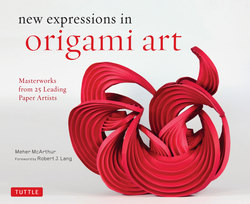Читать книгу New Expressions in Origami Art - Meher McArthur - Страница 9
На сайте Литреса книга снята с продажи.
ОглавлениеORIGAMI CONNECTIONS
Photo by Miri Golan
No other art combines the severity of constraint with an extravagance of expression like origami. So just what, exactly, is origami? Narrowly defined, it is the folding of brightly colored squares of paper into simple birds, fish and flowers. Broadly defined, it is a sculptural art in which the primary means of creating the form is folding. I and my fellow artists in this book take the broad view: we use folding as the springboard to express nature, philosophical ideas, mathematical concepts, even political statements. And yet, there is a thread of continuity that connects our diverse art with that of other artists, with the Japanese craft with which it bears kinship, and with the centuries-old manipulations of paper we find throughout the world.
Folding of paper-like materials exists in many cultures in Europe, Asia and the Americas. However, the deepest roots of the folding arts arise from within the Japanese folding tradition, and that is why most of us use the Japanese word “origami” to describe what we do. Those of us who do use the word “origami” recognize that it is a relatively recent term and an imperfect fit to the modern practice. The important thing is not the word: the important thing is what the various expressions of the art share with one another. Origami is a conservative art, in which material is neither added nor removed, but transformed. This transformation establishes a thread of continuity and integrity that connects the simplicity of the starting shape—commonly one or more squares or rectangles—with the folded form, be it representational or abstract. The finished form triggers our perceptions and evokes images and emotions, but that thread of continuity binds our experience of the finished work to the pristine initial shape. In the artist’s mind, there was an idea and a sheet of paper before any folding took place. In the finished work, the sheet of paper remains continuous and uninterrupted as it began, but with the artist’s concept now layered within the folds.
We transform via folding, but even folding is to be taken broadly. Folding is creasing, bending, curving, scoring, by hand, by fingernail, by folding bone, even by blade and laser. Folding preserves the paper’s initial shape, but at the microscopic level it imparts permanent change: breaking fibers, infinitesimally delaminating layers, and, if the technique of wet folding is applied, rearranging hydrogen bonds between adjacent polymeric strands. Folding can be mechanically precise, formed according to artistic judgment, or, in the case of “crumple” folding, formed as the realization of a stochastic process. However folds are created, they ultimately join together with the mechanical properties of the paper—stiffness, springiness, relaxation—and the intricacies of human perception in the observer to create a connection. Origami is about connections: between the fibers of the paper or folding medium, between the creases that join into intricate networks, but most of all between the artist and the observer of the finished work. As you explore the works in this book, I encourage you to examine the connections within the works displayed, both explicit and implied, and establish your own connections with this fascinating art.
ROBERT J. LANG
origami artist/consultant, physicist and author of Origami Design Secrets
